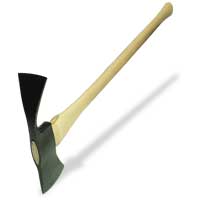 By Jacquie Rogers
By Jacquie RogersEdward C. Pulaski migrated west from his Ohio birthplace, and worked at several jobs before joining the Forest Service in 1908 at age 40. He knew the North Idaho mountains well, and it was a good thing because the summer of 1910 was extra dry and the entire forest was crackling tinder waiting to burst into flame. It didn't wait long.
 Fires started everywhere. Hundreds of men fought them all summer, but by late August all the fires, nearly 2,000, combined into one giant inferno. Men who fought fires were caught and feared for their very lives. In Pulaski's words:
Fires started everywhere. Hundreds of men fought them all summer, but by late August all the fires, nearly 2,000, combined into one giant inferno. Men who fought fires were caught and feared for their very lives. In Pulaski's words:On August 20 a terrible hurricane broke over the mountains. It picked up the fires and carried them for miles. The wind was so strong that it almost lifted men out of their saddles and the canyons seemed to act as chimneys, through which the wind and fires swept with the roar of a thousand freight trains. The smoke and heat became so intense that it was difficult to breathe.He found nearly fifty firefighters but then he had to convince them to listen to him. Fire safety techniques were not yet developed and he had to make them understand what he wanted them to do--and this is with the roaring fire and dense smoke interfering with the most basic of communication. The men were skeptical but he finally convinced them to heed his advice.
Pulaski knew about a mine tunnel and he led the men to it. The mud in the tunnel was soothing and the air was a little cooler, but the fire had sucked out a good share of the oxygen. Pulaski used his gun to threaten the men who, out of their minds, wanted to leave. In fact, some men did die in the mine tunnel that night, but many more lived. All owed their lives to Edward C. Pulaski.
The next day, several men made their way to Wallace, Idaho, which burned as well. A third of the town was lost to fire, but the men were able to get help for their comrades. As for Pulaski, his eyes were scorched and he was in the hospital, blind for a couple months.
 But that's not the end of his heroism. He invented the main firefighting and forestry tool used today, called--you guessed it--the pulaski. It's an axe on one side and a grub hoe on the other. It's a very handy tool and is used for everything from digging fire lines to planting trees.
But that's not the end of his heroism. He invented the main firefighting and forestry tool used today, called--you guessed it--the pulaski. It's an axe on one side and a grub hoe on the other. It's a very handy tool and is used for everything from digging fire lines to planting trees.He continued to work for the Forest Service for many years.
Ranger Pulaski died in 1931. Mount Pulaski, a 5,000-foot peak outside of Wallace, is named in his honor.
Sources:
Oregon Live
Polish Site
Wikipedia
 Jacquie Rogers writes quirky, magical romances. Available now are her contemporary western, DOWN HOME EVER LOVIN' MULE BLUES, a multi-era faery story, FAERY SPECIAL ROMANCES, and a Christmas story, FAERY MERRY CHRISTMAS. She's co-founder of 1st Turning Point, a pay-it-forward website where authors teach, share and learn promotion and marketing.
Jacquie Rogers writes quirky, magical romances. Available now are her contemporary western, DOWN HOME EVER LOVIN' MULE BLUES, a multi-era faery story, FAERY SPECIAL ROMANCES, and a Christmas story, FAERY MERRY CHRISTMAS. She's co-founder of 1st Turning Point, a pay-it-forward website where authors teach, share and learn promotion and marketing.